The ultimate achievement of a professional tennis player is and will always be winning the Grand Slams. Some good players win one or two Grand Slam titles in their career, a few great players win 10 or more Grand Slam events. The sense of satisfaction that one gets by winning a Grand Slam title cannot be described by words.
Roger Federer has talked about how special it felt when he won his first Grand Slam title at Wimbledon in 2003. To Roger, the first one will always remain extra special although he has added another 19 till date. Marion Bartoli, the winner of the 2013 Wimbledon Singles trophy spoke about how she sleeps with her Wimbledon replica trophy to relive the immense joy and satisfaction that she got through her victory.
It is one thing to win Grand Slams and be remembered for greatness. But having a Stadium named after you take it up a notch. The select group of elite individuals who have stadia named after them will be remembered for eternity even if the public does not necessarily refer to the glory that they brought during their playing days.
We take a look at 5 of the best tennis stadiums in the world that are named after great Grand Slam Champions :
#1 Court Suzanne Lenglen
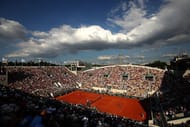
Built-in 1994 and originally referred to as 'Court A', Court Suzanne Lenglen is the secondary stadium after the Phillipe Chatrier Arena. It has a capacity of 10,068 spectators. Many key matches of the French Open are played on this court year after year.
The stadium is named after the great French tennis player of the 1920s - Suzanne Lenglen. Suzanne Lenglen was the first big women's tennis superstar. Suzanne Lenglen won 6 Wimbledon titles and 2 French Open titles in both Singles and Doubles format. She also won 2 French Open and 3 Wimbledon Mixed Doubles titles. Apart from Grand Slam success, Lenglen won the Gold in Singles and Doubles at the 1920 Antwerp Olympic Games. Her singles win-loss record of 341–7 (97.99%) is the best ever in professional tennis - men and women combined.
The courthouses an underground irrigation mechanism, the first of its kind, to regulate moisture content within its surface. The pathway connecting the Main Court (Philipe Chatrier Court ) and secondary Court (Court Suzanne Lenglen) is named Allée Marcel Bernard in honour of the 1946 French Open champion.
#2 Roy Emerson Arena
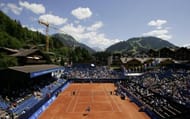
The Roy Emerson Arena is located in Gstaad Switzerland and has a capacity to house 4,500 fans. The stadium is the centrepiece of the Gstaad Suisse Open. The stadium was constructed in 1991.
The stadium is named in honour of Australian tennis great - Roy Emerson. Roy Emerson is the only male tennis player in history to have completed a 'Career Slam' in Singles and Doubles. Emerson won a record 6 Australian Open titles - a feat which is yet to be broken even to this day, 51 years after his last Australian Open win. Emerson is one of only 8 men to have won all 4 Grand Slam Singles' titles. At the time of retirement, Emerson with 12 Grand Slam titles held the record for most Grand Slam titles until Pete Sampras broke his record more than 3 decades later.
Roy Emerson is the only tennis player to have a stadium named after him in a country other than that of his own nationality.
#3 Margaret Court Arena
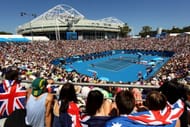
Australian tennis legend Margaret Court is the greatest tennis player of all-time looking at numbers. She won a record 24 Grand Slam Singles titles - a record which stands even today including an all-time record of 11 Australian Open titles. She is one of 3 women to have won all 4 Grand Slam titles in Singles, Doubles and Mixed Doubles categories. She is also the only woman to have completed the Calendar Year Slam in Singles and Mixed Doubles.
Show Court 1 at Melbourne has been hosting Australian Open matches since 1988. It was re-named as Margaret Court Arena in 2003. It has a seating capacity of 7,500.
In response to the issue of recurring heatwaves at the Australian Open, a retractable roofing system was constructed at the Margaret Court Arena - the third one to get such a system in Melbourne after the Rod Laver Arena and the Hisense Arena.
Of late, there have been calls to strip Margaret Court's name from the Stadium on account of requests from people who are opposed to her homophobic views. However, as of 2018, no such change has been made.
#4 Rod Laver Arena
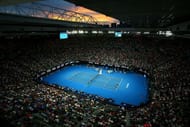
The primary court of the Australian Open is the Rod Laver Arena. The Rod Laver Arena replaced the Kooyong Stadium as the centrepiece of the Australian Open commencing from 1988.
The stadium was called as National tennis Centre between 1988 to 1995. From 1996 to 1999, it was just referred to as Centre Court. However, on 16th January, the stadium was re-named as Rod Laver Arena in a fitting tribute to one of Australia's greatest sons. The only player to win 2 Calendar Year Grand Slams, Laver won a total of 11 Grand Slams in his career and remains the only man to achieve the feat in the Open Era.
The Rod Laver Arena has a seating capacity of 14,820 and was the first arena in Australia to have a retractable roof. The Arena also hosts basketball matches and music concerts.
Barring the Australian Open. Rod Laver Arena was also the scene of Australia's great Davis Cup triumph in 2003.
#5 Arthur Ashe Stadium
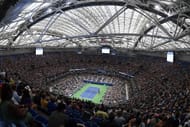
The biggest tennis stadium in the world by capacity (23,771) is the Arthur Ashe Stadium, New York. The central stadium of the US Open, it is part of the Billie Jean King National Tennis Centre at Flushing Meadows. A retractable roofing system was constructed at the Arthur Ashe Stadium only in 2016.
The stadium is named after Arthur Ashe, the legendary American tennis player who won the first US Open held in the Open Era in 1968. Arthur Ashe broke many barriers - from being the first black tennis player to get selected to the US Davis Cup Team to being the first black player to win a Grand Slam title. Ashe received the USA's highest honour - the Presidential Medal of Freedom posthumously in 1993.
Costing a whopping $254 million to construct, the Arthur Ashe Arena replaced the Louis Armstrong Arena as the central arena of the US Open in 1997.